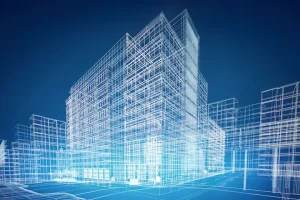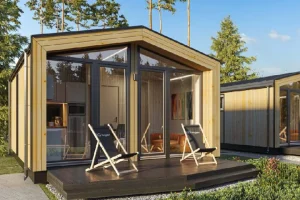Choosing the right frame for any project is of utmost importance, as it has a major impact on the strength, durability, cost, and construction time of the project. Different types of frames, including concrete, steel, wood, LSF, and prefabricated frames, each have their own unique features and benefits that must be carefully selected based on the needs of the project. Today, in this article, we are going to examine the prices of different types of frame. Stay tuned.
Checking the prices of various building skeletons
Given that prices in the construction industry are influenced by various factors such as market fluctuations, geographical area, availability of materials and economic conditions, exact prices may vary from time to time. However, we can provide you with approximate prices for some types of building frames. Stay tuned.
1. Concrete skeleton
Concrete framing is one of the most common and cost-effective options for constructing residential and commercial buildings. The cost of a concrete framing is usually calculated per square meter. The cost of implementing a concrete framing usually varies between 300,000 and 600,000 Tomans per square meter. This price depends on various factors, including the cost of materials (cement, rebar, sand) and labor costs. This price can increase if higher quality materials are used and in areas with more difficult access to materials.

2. Steel skeleton
Steel framing is more expensive than concrete framing due to the use of steel, which is currently one of the most expensive construction materials. The cost of implementing a steel framing is usually between 600,000 and 900,000 Tomans per square meter. This cost depends on factors such as the thickness of the beams and columns, the amount of welding or bolts, the cost of transporting the steel, and the project area. For larger buildings or structures requiring high-strength steel, costs may be higher.
3. LSF skeleton (light cold-rolled steel structure)
LSF frame is one of the new and lightweight structures that costs less than steel and concrete frames. The cost of implementing this type of frame is usually between 450,000 and 700,000 Tomans per square meter. The price of this type of structure depends on the type of steel profiles, thickness, and number of bolts and nuts used. Also, the high speed of implementation of this type of structure can reduce the overall cost of the project, and this type of frame is especially cost-effective in low-rise and residential projects.

4. Wooden frame
Timber framing is one of the oldest construction methods used in some projects such as low-rise buildings, villas and rural houses. This type of framing is usually less expensive and its implementation price is usually between 300,000 and 500,000 Tomans per square meter. Depending on the type of wood used and its quality, costs can vary. In general, using timber as the main structure in buildings that do not require high strength is a cost-effective option.
5. Composite skeleton
Composite frame is a combination of steel and concrete that is usually used for large projects such as bridges and high-rise buildings. This type of frame is usually more expensive and its implementation varies between 700,000 and 1,000,000 Tomans per square meter. This cost is due to the use of advanced materials and special technologies in the construction and connection of various components. Compared to steel and concrete frames, composite frame has more advantages, such as weight reduction and greater strength, but its implementation cost is higher.
6. Aluminum skeleton
Aluminum frame is used in some specific projects due to its light weight, corrosion resistance and environmental capabilities. The cost of implementing an aluminum frame is usually between 700,000 and 1,000,000 Tomans per square meter. This cost is due to the high price of aluminum and the technology used in the construction of this type of structure. In addition, the low maintenance costs and long life of this type of structure make this type of frame used in projects with a long life or high resistance requirements.
7. Precast concrete skeleton
Precast concrete frame is a type of concrete structure in which concrete parts are prefabricated in a factory and then installed at the project site. This type of frame is a popular option in large and industrial projects due to its high speed of installation and reduced need for formwork and concrete curing. The cost of implementing a precast concrete frame usually varies between 400,000 and 700,000 Tomans per square meter. This cost depends on the type of prefabricated parts, the amount of installation and transportation of materials.
In addition to the high speed of installation, this type of structure has good resistance to environmental conditions and fire. The use of prefabricated parts allows projects to be completed in less time and labor costs are also reduced. At the same time, due to the use of advanced technologies in the production of parts, the initial cost of this type of structure may be higher than traditional construction, but the time savings and reduced labor costs can make this type of structure more economical in the long run.
8. Light Steel Frame
Light Steel Frame (LSF) is another modern construction method that uses lightweight steel profiles. This structure is used in small residential and commercial buildings due to its light weight, high flexibility, and convenient installation speed. The price of implementing a light steel frame is usually between 400,000 and 600,000 Tomans per square meter. This price depends on the thickness and type of profiles, as well as the need for corrosion-resistant coatings.
The advantages of using a light steel frame include high construction speed, reduced building weight, and reduced maintenance costs. Due to the prefabricated components and their easy installation, the construction time of the project is reduced, resulting in reduced overall costs. This type of structure is usually a suitable option for projects with smaller dimensions and in areas that require earthquake resistance.

9. Tent skeleton
Tent frames or tensile structures are a unique type of structure that uses steel cables and durable tents to create large covers. This type of frame is used for special projects and buildings with curved and sloping roofs such as stadiums, exhibitions and large halls. The cost of implementing a tent frame is on average between 500,000 and 900,000 Tomans per square meter. This cost depends on the type of cables, tent fabrics and installation technology.
Tent frames are considered in projects that require large space construction due to their lightweight design, resistance to weather conditions and ability to create open spaces with column-free ceilings. Also, the quick installation of this type of structure and easy transportability are other advantages. This type of frame is more suitable for temporary spaces or projects that require a modern and curved appearance.
10. Prestressed concrete skeleton
Prestressed concrete frame is a type of concrete frame in which concrete is stressed to provide greater resistance to tensile and compressive forces. This type of structure is mostly used for bridges, high-rise buildings, and industrial projects. The cost of implementing a prestressed concrete frame is usually between 700,000 and 1,000,000 Tomans per square meter. This price is due to the use of special prestressing techniques and additional costs in its installation and implementation.
The main advantage of a prestressed concrete frame is the increased resistance of the structure to tension and compression. This type of frame is especially suitable for projects that require large spans and no columns. Also, a prestressed concrete frame has a longer lifespan and better resistance to earthquake forces. The higher implementation cost of this type of skeleton is due to the use of special techniques and the need for advanced equipment, but its durability and high performance make it valuable for specific projects.
Key points in choosing types of building skeletons
1. Project type and construction needs
One of the key points in choosing a building frame is to consider the type of project and its specific needs. For residential, commercial, industrial projects, or large, specialized projects such as bridges, the choice of frame type should be made according to the characteristics and use of the building. For example, concrete or steel frames are usually used for small residential and commercial buildings, while prefabricated or tent frames will be more suitable for larger projects such as stadiums or industrial spaces. This choice affects not only the strength and durability of the structure, but also the costs, construction time, and maintenance.
2. Project cost and budget
The most important factor in choosing the type of building frame is the costs related to implementation and raw materials. Depending on the type of frame (concrete, steel, wood, LSF, etc.), prices vary. For example, the cost of a steel frame is usually higher than a concrete frame, but this type of frame is more suitable for large projects with high strength requirements. In general, a careful review of the budget and consideration of the costs of materials, installation, labor, as well as long-term maintenance costs are essential when choosing the type of frame. If the budget is limited, options such as lightweight or prefabricated frames can be a more economical choice.
3. Construction time and execution speed
Construction time is another factor to consider when choosing a building frame. Some types of frames, such as precast and LSF frames, have a shorter construction time due to the prefabrication of components and faster installation. Compared to concrete and steel frames, which require more time for formwork, concreting and drying, prefabricated and lightweight steel frames can significantly reduce the overall project time. For projects that require rapid completion, it is very important to choose frames that are installed faster, such as lightweight or prefabricated steel frames.
4. Structural strength and durability
The strength and durability of a building frame are particularly important against earthquakes, wind, heavy loads, and other environmental stresses. Steel frames are more suitable for high-rise projects or projects that are subject to heavy loads due to their high tensile and compressive strength characteristics. Prestressed concrete and composite frames can also be good options for projects with large spans and no columns. Considering geographical conditions, soil type, environmental conditions, and the possibility of natural disasters are among the factors that should be considered when choosing the type of frame to ensure the strength and safety of the structure in the long term.
5. Long-term maintenance and durability
The durability and need for long-term maintenance of the building frame should also be considered in its selection. Some types of frames, such as steel and concrete, require less maintenance, while wooden frames may require constant repairs and care due to their sensitivity to moisture and insects. Steel and concrete frames have a longer lifespan and are resistant to environmental damage such as rust and corrosion. Therefore, by choosing highly durable frames, frequent maintenance and repair costs can be avoided in the long run and the useful life of the structure can be increased.

Final Words
As you can see, in this article, we have thoroughly examined the prices of various types of building frames. We learned that choosing the type of building frame depends on several factors that must be carefully evaluated. These factors include the type of project, cost, speed of execution, strength, and maintenance needs. Each type of frame has its own characteristics that can affect the final decision. By considering these points and careful evaluation, a correct and optimal decision can be made that is both beneficial to the project and effectively meets the future needs of the project. Thank you for your support until the end of this article. Ohaddeco Group specializes in the design and production of LSF structure, various KIT HOUSE structure, and interior coatings such as wooden acoustic wall covering and wooden thermowall. Contact us for more information.




